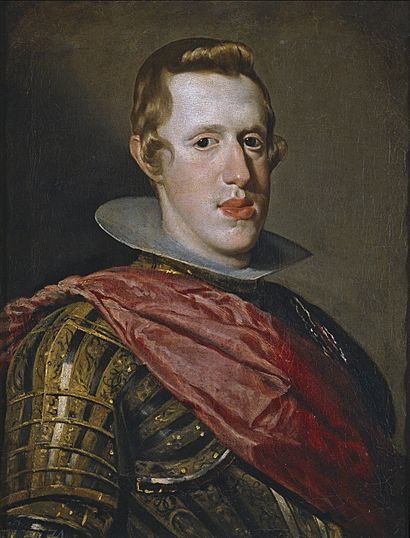Portrait of Philip IV in Armour facts for kids
Quick facts for kids Portrait of Philip IV in Armour |
|
|---|---|
 |
|
| Artist | Diego Velázquez |
| Year | c. 1623 |
| Medium | Oil on canvas |
| Dimensions | 57 cm × 44 cm (22 in × 17 in) |
| Location | Museo del Prado, Madrid |
The Portrait of Philip IV in Armour is a famous painting of Philip IV of Spain. It was created by the talented Spanish artist Velázquez. You can see this artwork today at the Museo del Prado in Madrid, Spain.
This painting is special because it's one of the most realistic pictures Velázquez ever painted of King Philip IV. It was also one of the very first paintings Velázquez made after he became the official painter for the king in 1623. The style of the painting shows how Velázquez started his career in Seville. It makes the king look strong and solid, almost like a statue. The colors in the painting also have strong, clear differences.
About the Painting
This portrait shows Philip IV of Spain wearing his armor. It's a very important piece of art by Diego Velázquez, who was one of the greatest painters of his time. The painting helps us understand what the king looked like and how artists worked in the 1600s.
Who Was Philip IV?
Philip IV of Spain was the King of Spain and Portugal from 1621 to 1640. He ruled for a very long time. During his reign, Spain was a powerful country, but it also faced many challenges. Kings like Philip IV often had their portraits painted to show their power and importance.
Who Was Velázquez?
Diego Velázquez was a Spanish painter who lived from 1599 to 1660. He is known for his amazing portraits of the Spanish royal family. He was the main painter for King Philip IV. Velázquez was very skilled at making his paintings look real and full of life. His work is still admired by many people today.
The Painting's Style
When Velázquez painted this portrait, he used a style that made the king look very strong and almost like a sculpture. This was part of his early way of painting. He used sharp differences in colors, which means some parts of the painting are very bright and others are very dark. This creates a dramatic effect.
See also
- List of works by Diego Velázquez
- In Spanish: Felipe IV (1626-1628) para niños

